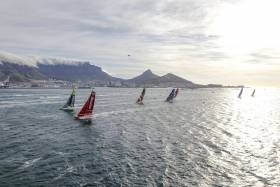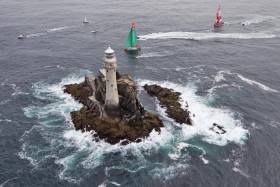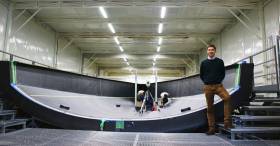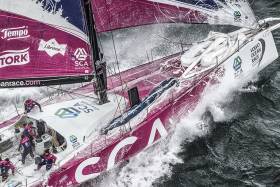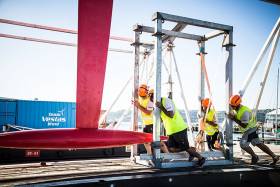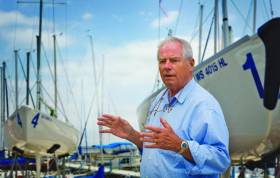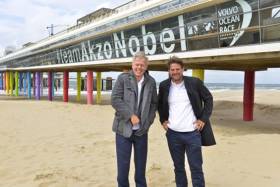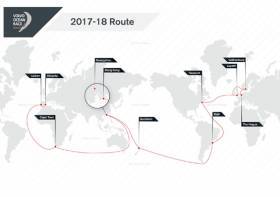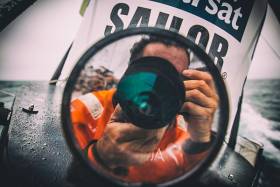Displaying items by tag: Volvo Ocean Race
#VOR - The 2017-18 Volvo Ocean Race will begin less than a year from now on Sunday 22 October, when the starting gun is fired in Alicante and the teams set out to complete a total of 45,000 nautical miles of offshore racing, over a course that takes in 11 landmark cities in five continents over eight months.
Organisers have also revealed the start dates for the first three legs of ‘sailing’s longest and toughest adventure’, rounding off a series of 10 major announcements on the future of the VOR over the past two weeks.
The first official action of the 2017-18 edition will be the Alicante in-port race on Saturday 14 October before the race proper begins eight days later with Leg 1, a 700nm sprint to Lisbon that also marks the fourth consecutive start from the race’s home port.
After arriving in Lisbon, the boats will take part in the in-port race on Saturday 28 October before the start of Leg 2 on Sunday 5 November.
That leg will see them battle it out over three-plus weeks and 7,000nm of the Atlantic Ocean to Cape Town, the 11 occasion in 13 editions that the Volvo Ocean Race has visited the South African city.
The Cape Town in-port race will take place on Friday 8 December and Leg 3 will begin two days later on Sunday 10 December.
VOR organisers say the decision to tweak the format of race weekends at many of the stopovers by moving the in-port race from the Saturday to the Friday gives teams an extra 24 hours to prepare for the rigours of ocean racing to come.
“With just a year to go, the countdown to the Volvo Ocean Race 2017-18 has begun,” said VOR chief executive Mark Turner. “The sailors can look forward to an unforgettable send-off from Alicante, our home port, and the fact that they’ll be thrown into a high intensity sprint to Lisbon straight off will make Leg 1 especially exciting.
“Our Boatyard facility is based in Lisbon, and it will be very well known to teams who will use it as an Atlantic training base in the lead-up to the start.”
Turner added: “Cape Town also has a special connection with the Race – our boats have been heading there since the very first edition, back in 1973 – so there will be a lot that is very familiar before the teams head towards the Southern Ocean, which is such an important focus for the race.”
The full route, including almost three times the amount of Southern Ocean sailing as in recent editions, was announced earlier this year. Organisers will announce dates for the rest of the legs in the coming weeks.
Fastnet Race Joins VOR Qualifying Schedule
#VOR - The Rolex Fastnet Race has been named among the mandatory qualifiers ahead of the start of the 2017-18 Volvo Ocean Race.
The famed run from the Isle of Wight to Fastnet Rock in West Cork joins the new Lisbon-Alicante prologue — and a provisional transatlantic challenge over the summer — in the pre-race series that will serve as the first fight for dominance among the now eight-strong fleet.
‘Leg Zero’, as organisers have dubbed the new qualifier, comprises the traditional Fastnet Race route with an additional course from Plymouth to Lisbon.
Many VOR teams have used the Fastnet Race in their preparations – Team SCA and Abu Dhabi Ocean Racing being the most recent, in the 2013 race — but never before has it been a mandatory qualifier.
“I’ve done a few Fastnet Races, some were windy and some were light,” said Charles Caudrelier, skipper of Dongfeng Race Team in the 2014-15 VOR.
“It’s a nice course, very fun and interesting to sail around the coast, with the effect of the currents. It’s a good test and a very dynamic race, with interesting weather.”
According to race operations director — and VOR veteran — Richard Mason, the Fastnet Race “is on the bucket list of every ocean racer in the world.
“It’s famous for being very tricky and coastal. You can have no wind, you can have enormous amounts of breeze, and vicious seas, out near Fastnet Rock, it’s navigationally and tactically challenging, you don’t get much sleep.
“It’s the perfect race – an amazing thing to be a part of.”
Volvo Ocean Race Fleet Grows To Eight For Next Edition
#VOR - An eighth boat will join the fleet for the 2017-18 edition of the Volvo Ocean Race, organisers have announced.
Currently under construction at Persico Marine in Italy, the new Volvo Ocean 65 one-design will be launched in May 2017 with a team to be announced early in the new year.
"It’s exciting to welcome an addition to the fleet ahead of the next edition, as this was not necessarily expected,” said Nick Bice, VOR director of boats and maintenance.
“We now have a real prospect of starting the next race with more boats than in the last edition."
Persico Marine will use the same moulds, materials and process from the built for the original fleet of seven yachts that raced the 2015-15 edition.
And Bice says the boatyard will be open to inspection by all other teams to ensure complete transparency.
"Our tests on the existing boats have shown they have not lost any of their rigidity or performance, so whilst the team building a new boat will have ‘no excuses’ from a mental perspective perhaps, there will be no real advantage in physical terms,” he added.
The rest of the fleet is also undergoing a refit to prepare them for a second gruelling 45,000-nautical-mile journey around the world, starting from Alicante a year from this month.
The news comes after a rule change to provide female sailors with a clearer pathway to competing in the race in the wake of Team SCA’s achievements in 2014-15.
Another rule change, among 10 announcements VOR organisers are making this month, will allow for real-time social media communication by race teams’ onboard reporters without compromising strict rules against internet access.
Female Sailors Given Clearer Pathway in Volvo Ocean Race Rule Change
The Volvo Ocean Race is making a major rule change to give world-class female sailors a much clearer pathway to compete at the highest level of offshore sailing in the 2017-18 edition.
In the first of a series of ten announcements that the Volvo Ocean Race will make over the next two weeks, the rules of the race will limit all-male teams to seven sailors, one fewer than in 2014-15, and give mixed teams a significant numerical advantage.
- All-male teams still permitted, but adding the world’s best female sailors is incentivise
- Different crew combinations possible on different legs, giving skippers room to follow various selection strategies according to the expected weather conditions
- Under-30 rule fine-tuned to squeeze age of ‘youth’ sailors down further
The possible crew combinations for 2017-18 will be:
- 7 men;
- 7 men and 1 or 2 women;
- 7 women and 1 or 2 men;
- 5 men and 5 women;
- 11 women
Teams will be able to change their crew combinations from leg to leg in the race, which starts from Alicante in October 2017 and visits 11 cities around the globe, but as in previous editions, teams will be required have the same crewmembers on board for the In-Port Race as either the previous or the subsequent offshore leg – with the exception of a team that is racing offshore with 7 males who can add an additional female for the in-port racing.
Ian Walker, Volvo Ocean Race 2014-15 winning skipper, and Olympic silver medallist, commented: "If female offshore sailors ever want to compete at the same level as the best in the world then they need to train and race with the best.
“It would be very hard to compete with only seven people on a Volvo Ocean 65 against teams of eight or nine. This new rule will almost certainly force teams to hire women and that will create a great platform for learning."
The move follows the success of Team SCA’s 2014-15 campaign, which saw an all-female crew finish third in the In-Port Race series and become the first to win an offshore leg in 25 years – but still saw a ceiling in their offshore performance overall without being able to learn from the more experienced sailors once out on the ocean.
“This is not about lowering the standard as some in the sport will suggest – the reverse – it is giving more opportunity to the very best female sailors in the world to compete on equal terms," said Mark Turner, Volvo Ocean Race CEO, who masterminded Briton Dame Ellen MacArthur’s successful Vendée Globe race in 2001, where she finished second.
"Sailing is one of the few sports where you can have mixed teams, and we want to take advantage of that, and also reflect the growing desire for greater diversity in businesses – in particular the kind who back the race teams today.
“The Team SCA project in the last race did a great job to restart female participation, after 12 years with just one sailor getting a slot [Adrienne Cahalan, Brasil 1, Leg 1 2005-06]. We’re determined to build on that momentum, and we want to guarantee that the Volvo Ocean Race continues to have the very best sailors competing in the race – both male and female.”
He continued: “We’re using the crew rules to incentivise skippers to bring one or more female sailors onboard. I really hope that it’s not necessary to have any rule at all in the future – but it seems it’s the only way today to ensure we can maintain progress.”
The race, which celebrated its 43-year anniversary last month, has a long history of female sailors, with over 100 women having competed since its inception in 1973, compared with over 2000 men.
“We’re determined to maintain our female presence in the Race – the proportion of women in sailing is growing all the time, and we think that it’s important that, as sailing’s leading offshore property, we maintain a representative demographic,” explained Race Director, Phil Lawrence.
And news of the move has already attracted a positive reaction from many female sailors.
"This is fantastic news for elite female athletes not just in sailing, but in sport as a whole,” said Dee Caffari MBE, who raced onboard Team SCA in 2014-15 and, in 2006, became the first female to sail solo and non-stop the ‘wrong way’ around the world.
“It was important to make a big impact with an all-female team last edition in order to change the perception of women in sailing, and we showed that we could compete on the same boats, in the same conditions.”
She added: “I’m excited to see the concept of mixed teams evolve. I do believe that there are enough female sailors out there who can step up and prove that they can perform, deliver and earn a place onboard.”
The race has also reaffirmed the commitment to youth sailing, with a rule that two crew must be under the age of 30 at the end of the race in July 2018.
Volvo Ocean Race Begins Unique Refit process in Lisbon
A unique refit process is underway in Lisbon, with the first of the fleet of seven one-design Volvo Ocean 65s going in for a complete overhaul ahead of the next edition of the Volvo Ocean Race this time next year.
- The Boatyard begins process to overhaul entire Volvo Ocean 65 one-design fleet
- Work on each boat will take around 15 weeks
- Process to be completed by June 2017, four months before the start of 2017-18 edition
The start of the next race is still over a year away – but at the state-of-the-art Boatyard facility in Lisbon, Portugal's capital, the boatbuilding team is already working against the clock.
The boats will collectively undergo a stringent re-fit process, based around reliability, to ensure that they can race another 45,000 miles around the planet.
Work on each will take around 15 weeks, but the process will be staggered to allow a new boat to enter the facility every three weeks.
"To say we're on a challenging schedule is an understatement," said Sam Bourne, Head of the Boatyard's Deck Gear Division.
"We have seven boats to upgrade between now and next summer. Every three weeks a boat will come in, and from January 2017, we'll start to push the boats out and hand over to the teams. There's not a moment to waste."
It is the first time in the history of the race that a one-design re-fit process has been undertaken. It will be completed in June 2017 – four months before the start of the next edition in October 2017.
“The boats ended the last race in fantastic condition,” said Nick Bice, Director of Boats and Maintenance at Volvo Ocean Race, as the first boat from the 2014-15 edition began the refit process this week.
The first boat going into the refit process was raced by Dongfeng Race Team in the 2014-15 edition.
“When a boat comes out of this re-fit process it will look brand new, with a new paint job. You won’t be able to tell they’ve ever been in the water, never mind raced and trained over 60,000-70,000 miles through the toughest conditions on earth.”
He added: “We’re making some changes across the boats using our learnings from last edition to ensure that they’re even more reliable than before – and we’re also modifying the sail inventory, combined with several other upgrades all taking safety, reliability and technological advancement into account.”
The Boatyard facility, which opened in Lisbon in May this year, will serve as a pre-race training hub for the fleet, allowing teams to access Atlantic conditions as they prepare for the gruelling next race which will see them race three times more miles in the Southern Ocean than in recent editions.
Bice added: “The building we’re using to house the Boatyard is an old fish market. If you were to design and build a facility to undertake these upgrades to the boats, you wouldn’t be able to design it better than what’s already here in the docks in Lisbon.
“The training options are almost limitless. You can go up around the corner, around Cascais and be virtually guaranteed wind at any stage. Equally, you could train in the Tagus River to practise in light air scenarios.”
The maintenance centre based at Race HQ in Alicante will continue to be available for teams as a Mediterranean training and support base.
North Sails Pays Tribute To Late Terry Kohler
#NorthSails - North Sails has paid tribute to Terry Kohler, owner of the company from 1984 to 2014, who died at his home in Wisconsin on Tuesday 20 September, aged 82.
Part of a business and political dynasty in his home state, Kohler was still at the helm of the company when it began supplying the sailing wardrobe for the Volvo Ocean Race. North Sails is now the exclusive sail supplier for the Volvo Ocean 65.
As a graduate of MIT, Kohler – who bought the company from Lowell North on the latter's retirement – saw the potential in marrying the latest technology with tried-and-tested deck knowledge to produce market-leading sails.
But he was also just as passionate about wildlife conservation, with he and his second wife Mary dedicating efforts to protect vulnerable marine species such as trumpeter swans, whooping cranes and Siberian cranes.
The North Sails website has more HERE.
#VOR - Dutch campaign Team AkzoNobel has today (Tuesday 5 July) been announced as the first entry of the 2017-18 Volvo Ocean Race – more than 15 months before the start of the next edition.
Backed by AkzoNobel – a leading global paints and coatings company headquartered in Amsterdam whose portfolio includes well-known brands such as Dulux – the boat will be led by first-time skipper Simeon Tienpont, who will be racing in his third Volvo Ocean Race.
Having made his debut as a rookie onboard ABN AMRO TWO in 2005-06, the Dutchman to the world’s toughest offshore race to join Team Vestas Wind for the final two legs of the 2014-15 edition – and is delighted to be leading his homeland's campaign.
“I’m honoured and incredibly excited to be skipper of Team AkzoNobel,” said Tienpont, 34, who has also been part of two winning America’s Cup teams – BMW Oracle Racing in the 33rd edition, and Oracle Team USA in the 34th edition – in an illustrious sailing career.
“We’re both focused on high performance and share the same passion for success,” he continued. “I can’t wait to start racing.”
Conrad Keijzer of AkzoNobel's executive committee added: “Partnering with Simeon to form Team AkzoNobel is a winning combination – he’s a true leader who puts safety and teamwork first and is both determined and inspirational.”
Meanwhile, VOR chief executive Mark Turner said he was delighted that a Dutch entry was the first to declare for the 2017-18 race.
“It’s exciting that our first team announcement comes early in the cycle, is backed by a global brand, and features a first-time skipper," he said. "Those are three great positives for the Volvo Ocean Race.”
Turner also made note of the recently confirmed route for the next edition, which features "more action, more speed, more tough miles and more host venues".
Team AkzoNobel marks a revival of what's been a winning tradition for Dutch sailing in the Volvo Ocean Race and its predecessor the Whitbread, with Dutch teams having lifted the trophy three times, – in 1977-78, 1981-82 and 2005-06.
Dutch sailing legend Conny van Rietschoten remains the only skipper in the history of the race to have won two editions in a row.
And Tienpont, who in 2013 won the prestigious Conny van Rietschoten trophy, the highest honour in Dutch sailing, is proud to be following in the ‘Flying’ Dutchman’s footsteps.
“The Netherlands are very fond of this race and that’s all because of Conny van Rietschoten,” he said. “He brought the event, then called The Whitbread, to an entirely new level. He built his boat in an excellent Dutch boatyard and recruited professional sailors from all around the world.”
Visiting 11 cities across five continents, the Volvo Ocean Race represents a unique opportunity for AkzoNobel, which has a presence in over 80 countries, to showcase its products before a huge global audience.
“Add in Simeon’s impressive track record and it’s this irresistible combination of experience, tradition, expertise and human endeavour which will prove so vital once the world’s premier offshore race is underway," said Keijzer.
To celebrate the announcement of the Dutch team in The Hague, the Scheveningen pier underwent a colourful makeover, which will remain a remarkable eye-catcher until the race finishes with a grand finale in The Hague in summer 2018.
Volvo Ocean Race Returns To Southern Ocean Roots
#VOR - The next edition of the Volvo Ocean Race will be contested over the longest distance in race history at around 45,000 nautical miles,
Crossing four oceans and taking in 11 major cities on five continents, the 2017-18 race will also feature nearly three times as much Southern Ocean sailing as the previous edition, marking a return to its roots.
The VOR fleet will start from Alicante in late 2017 with a 700nm sprint to Lisbon that will provide the first test of the form guide.
From the Portuguese capital, the fleet will plunge south towards Cape Town in South Africa, before an epic few weeks racing through the Southern Ocean and then back north across the equator to Hong Kong in what promises be one of the longest legs in VOR history.
After a non-scoring transition to Guangzhou, China, where an in-port race and full set of stopover activities will be held, the ocean racing will resume from Hong Kong to Auckland, New Zealand.
The fleet will then head back through the Southern Ocean, around the most famous landmark of them all, Cape Horn, and up through the Atlantic Ocean to the southern Brazilian city of Itajaí.
From there, as in the last edition, the boats will head back in to the northern hemisphere to the Eastern Seaboard of the USA and Newport, Rhode Island before a blast across the North Atlantic on the blue riband transatlantic leg, which will see them make a first return to British shores in 12 years.
The fleet will arrive in Cardiff, capital city of Wales, in May 2018 before beating its way around the top of the British Isles on a short but potentially brutal leg to the penultimate stopover in Gothenburg, Sweden.
The 2017-18 race will end with a grand finale into The Hague in the Netherlands.
The total distance of the racetrack is longer than in any of the 12 previous editions of an event which was born as the Whitbread Round the World Race in 1973.
But while the teams will sail more nautical miles than ever before, the race itself is scheduled to be one month shorter than in most of the last 12 editions.
“More action, more speed, more tough miles and more host venues, but a shorter race – it’s an evolution in the right direction and a move that takes the race closer to its original roots and heritage, while improving its strong commercial value and excellent business case for sponsors,” said Mark Turner, who took over as CEO of the Volvo Ocean Race earlier this month.
Around 12,500nm of the race will take place in the Southern Ocean, the fast-moving, ice cold waters around the Antarctic where, unhindered by land, some of the deepest weather depressions circle the bottom of the global, generating giant waves and punishing, heavy winds that can peak at over 70 knots (130 km/h).
In the previous edition, the teams spent around 4,500nm racing in the Southern Ocean.
“In 2017-18 we’ll be visiting some of the world’s most famous sailing cities – places like Cape Town, Auckland and Newport, Rhode Island – while also taking the Race to fresh audiences in new cities,” said Turner as the route was unveiled today (Wednesday 29 June).
“Firstly to Hong Kong, an incredible city, which will act as a hub for south-east Asian fans and VIP guests. Then on to Guangzhou, China – the first time the race will visit one of just four premium Tier 1 cities in the country.
“And finally to Cardiff, taking the Race back to the UK for the first time since 2005-06. The United Kingdom is the birthplace of The Whitbread Round the World Race, which had its first start from Portsmouth in 1973 and later became the Volvo Ocean Race in 1998.”
Looking forward, Turner added: “It’s also great to be preparing for a fourth consecutive start from our home port of Alicante, and heading back to familiar cities where we’re building a legacy for the Race – to Lisbon, Itajaí, Gothenburg and The Hague.”
Race operations director Richard Mason also commented: “In the last edition we welcomed over 2.4 million visitors and over 70,000 corporate guests to our host city venues.
"We’re determined to offer even more exciting sailing in 2017-18, while making the race village experience even better for our fans, guests and partners.”
Mason, himself a five-time Volvo Ocean Race sailor, added: “I’m pretty tempted to return to the sailing now I’ve seen this amazing new route, but my new CEO has banned me!”
The Southern Ocean has played an huge role in the history of the Volvo Ocean Race. In the early years of the Whitbread, the fleet would head as deep into the Southern Ocean as possible, braving the icebergs and ferocious winds of the Roaring Forties and Furious Fifties in order to shave as much distance off the route as they could.
In more recent editions, the boats have raced north through the Indian Ocean, towards the Middle East – and have only returned to the south and its more extreme weather for the shorter leg across to Cape Horn.
“Of course, safety remains paramount,” said Phil Lawrence, incoming race director. “With state-of-the-art tracking systems and satellite communication, alongside access to in-depth route information, we can stay one step ahead of the conditions and limit the exposure of the sailors.
“But ultimately, there will always be danger. Sailors know they put their lives on the line when they take on ‘the Everest’ of professional sailing. That’s what the Volvo Ocean Race is all about – taking the toughest conditions that Mother Nature can throw at you, and overcoming them.”
#VOR - A world-leading carbon fibre specialist and supplier of masts and rigging to the Volvo Ocean Race fleet has taken a spin at supplying wheels to New Zealand's Olympic cycling team.
Auckland-based Southern Spars is already a long-time supplier to Team New Zealand as it has been to the VOR, but this marks the first time they've developed technology for sporting use off the water.
“The collaboration with Cycling New Zealand has been about taking [our] expertise and applying it in a different context - working together to create a significant performance benefit," said Southern Spars director Mark Hauser.
“We have drawn on our years of experience in the design and manufacture of carbon fibre technology and components. This has led to high performance in yachting, as well as specialist knowledge of windage, stiffness, and strength.
"In doing this, we have designed a new, superior wheel, which we’re delighted to be supplying to the New Zealand track cyclists.
Hauser said he and the Souther Spars team are "very excited by the potential of the new wheels" which will have their first major showing on an international stage at the Rio games this August.
If you died tomorrow, could you say you truly lived your life to the full?
That’s the question the Volvo Ocean Race is posing in its new online campaign as it bids to discover the next batch of brave Onboard Reporters willing to tackle the world’s most famous offshore challenge in 2017-18.
Dubbed ‘the toughest job in sports media’, it’s a unique role that certainly isn’t for the faint-hearted. No other sport features dedicated multimedia journalists embedded within teams of athletes and prospective candidates will have to survive a creative ‘boot camp’ proving their ability to stand the mental and physical pressure of the role, before being accepted.
The event, which since 1973 has pitted the best professional sailors on the planet against each other over 40,000 nautical miles, covering four oceans, five continents and nine marathon months, requires multi-skilled and experienced media professionals to join the crews onboard and report back to shore from the most remote and hostile regions on the planet.
“For a professional storyteller, I’m certain that there’s no greater challenge on earth than this,” explains American filmmaker Amory Ross, who has performed the role in the last two editions of the race.
“You are pushed far beyond your physical, mental and creative limits in a way that can compare with little else.”
To push content from the world’s oceans to race fans takes some serious technology. Every boat is fitted with state-of-the-art equipment, remote-control cameras, microphones and custom-designed media stations.
Cutting-edge communications support, provided by Inmarsat since 2005, delivers daily multimedia content to serve a global audience of tens of millions - via high-speed satellites - from each of the super-charged 65-foot racing boats while at sea.
The ideal candidates to join the elite storytelling squad will be capable of producing high-quality video, photo and written content on a daily basis, whatever the conditions.
“We’re looking candidates with an adventurous streak, but also with a history of solid media experience, an eye for a shot and a nose for a story,” explains Leon Sefton, who is leading the OBR recruitment project and is Head of Television at the Volvo Ocean Race.
“It cannot be underestimated how tough this role is to perform, day in, day out, in boat-breaking conditions and with little to no sleep.”
Over 2,000 hopefuls applied for the position in the last edition in 2014-15, and organisers are expecting an even bigger number of applications this time around.
The work of the Volvo Ocean Race Onboard Reporters is regularly featured across some of the world’s most recognisable media outlets, such as The Daily Telegraph, the New York Times, Red Bull Media House and 242 broadcasters on 83 television channels around the globe.
“The Onboard Reporters in the Volvo Ocean Race need to be much more than just a pretty face with a microphone. In fact, they may be performing the toughest job in sports journalism,” wrote award-winning journalist Tim Wendel in a Huffington Post story.
To apply, potential candidates should visit the campaign website, if.volvooceanrace.com, and follow the brief to produce example work.
If selected, they will move through to the next round where a formal interview will take place. Then they will be one step closer to joining the world’s most adventurous media team.




























